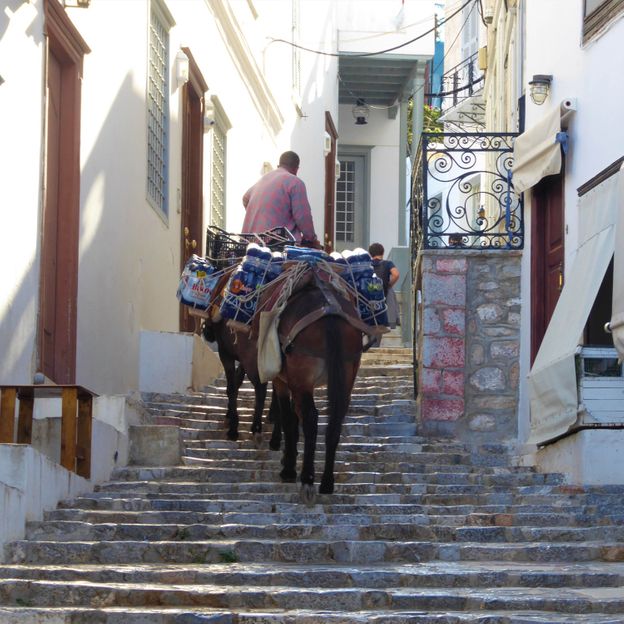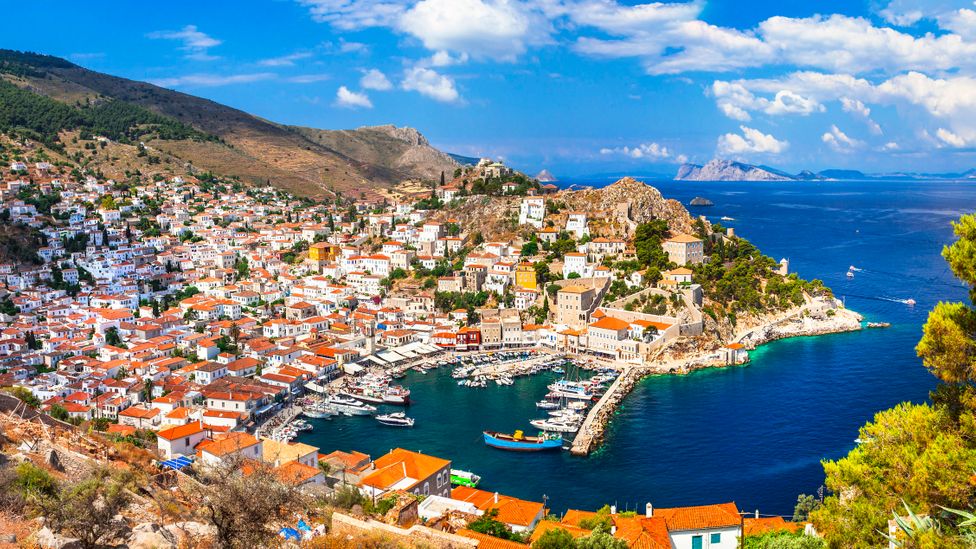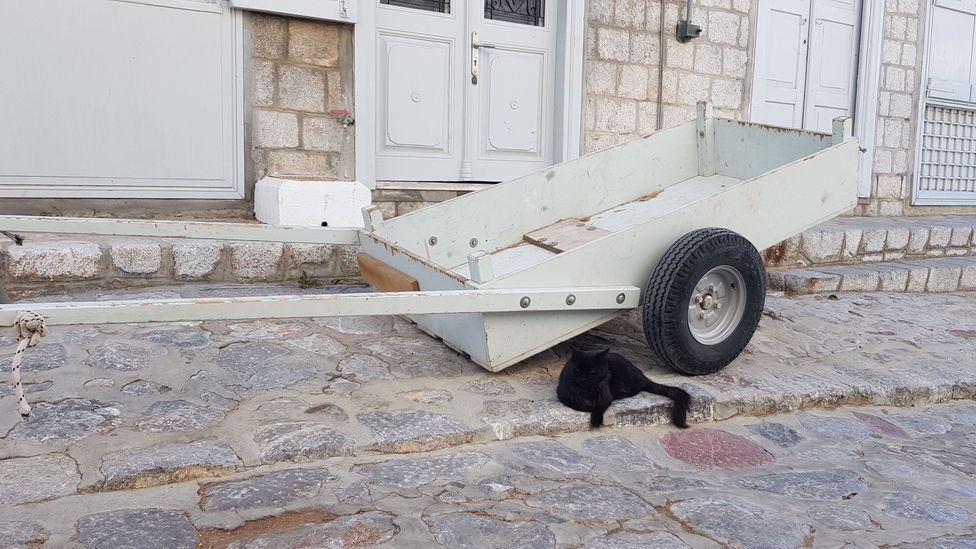Hydra: The Greek island that banned wheels
(Image credit: f8grapher/Getty Images)

A growing number of places around the world are looking to reduce reliance on cars. What lessons can be learned from a place that never allowed them in the first place?
O
On my final morning in Hydra, I woke up early and ambled down to the waterside to watch the weekly deliveries. Docked at the stone harbour walls was a barge that brings over islanders’ orders from the mainland. Patiently queuing to board the boat were several donkeys. Groups of three or four would climb aboard then return a few minutes later bearing household items, packages and even bags of cement in woven baskets strapped to their backs. The donkey drivers – all moustachioed island men – quickly led their charges away up alleys leading off the port and out of sight.
Hydra’s archaic reliance on donkeys for transport stems from a 1950s presidential decree that is intended to preserve the Greek island’s architecture and character. It includes a rule that wheeled vehicles – cars, motorbikes and even bicycles – cannot be used there. Since the town is built on steep, amphitheatre-like hills rising from its horseshoe-shaped harbour, donkeys are the only form of transport that can climb the steep steps and narrow alleyways up to many residents’ homes.
Municipalities around the world are currently looking at ways to reduce reliance on private cars, or even ban them from certain parts of a city altogether. Indeed, the London borough I live in has recently introduced a “low traffic neighbourhood”, a scheme that uses number-plate recognition cameras to restrict through-traffic so only residents can drive there. So, towards the end of an island-hopping holiday through the Greek islands, I was intrigued to see what a place that had never permitted cars was like.

Donkeys are the only method for transporting goods up town’s steep hills and alleys (Credit: Molly Dailide)
On first impressions, car-free island life felt idyllic. In towns on other Greek islands, I’d found myself regularly pressed up against walls on pavement-less roads to let mopeds buzz by. In Hydra, by contrast, I could wander around at my own pace, gawping at pink bougainvillea cascading down whitewashed walls, citrus and pomegranate trees in gardens and pretty squares framed by red pantile-roofed buildings.
Exceptions to the rule
Despite the presidential decree, visitors to the island may occasionally see a handful of vehicles, including a town rubbish truck. And while forbidden for adults, bicycles are allowed for children up to the age of 12 – but they can only be ridden in the winter months and not during the tourist-heavy summer.
It was also remarkably quiet; none of the screeching brakes or roaring engines typical of towns and cities elsewhere. Occasionally I heard a donkey honking or church bells clattering, but otherwise silence reigned.
The town also felt very human in scale. Walking up the maze of narrow streets and alleys to get a view over the harbour, I frequently saw groups of friends and neighbours greeting one another, chatting and gossiping in the middle of the road. One evening a group of kids ran past my table as I drank a beer by the port, bashing each other with balloons, their parents with no anxiety about traffic. Even the countless stray cats, a familiar feature of Greek islands, seemed unusually relaxed – often sprawling out lazily in the middle of thoroughfares.
I’m hardly the first outsider to be enchanted by Hydra, which has a long history of tourism and has also attracted a bohemian set. Canadian songwriter Leonard Cohen famously bought a house here in the 1960s and penned Bird on a Wire during one of his stays. Dina Adamopoulou, who works at Hydra’s historical archives, told me several painters including Picasso, Chagall and countless Greek artists have also paid visits.

Hydra is known for its peace and quiet, something that has long attracted tourists (Credit: Anton Petrus/Getty Images)
For tourists like me, the fact that Hydra is car-free makes it a lovely place to visit. But what about the roughly 3,000 people who actually live here? How does a place work in the modern world without wheeled transport?
“We regularly catch fire,” said Kelsey Edwards, an Englishwoman who’s lived on Hydra for more than 20 years and runs HydraDirect, a local information and property website. “Every summer, fire planes have to come over from the mainland and dump water on wildfires.” Edwards explained that since much of the island is inaccessible due its lack of roads, the local firefighting volunteer groups are unable to put out conflagrations on their own. Even when blazes break out near Hydra town itself, which is the only significant population centre, “everyone has to run and manually carry up water to put the fire out”.
And fires aren’t the only time where a lack of vehicles is a hindrance. “We can’t just dial [emergency services] and get an ambulance,” Edwards continued. She said that when people have health emergencies, getting to the town’s small medical centre can be very difficult, especially for those who live higher up the steep sides of the hills. Often, people need to be brought down by stretcher or on the back of a donkey to get seen by medics, which Edwards said can feel rather undignified.

Hydra’s car ban stems from a 1950s presidential decree to preserve the island’s architecture and character (Credit: Freeartist/Getty Images)
I also spoke to Rebecca Eptakili, the manager at my hotel, who has lived in Hydra for the past 38 years. “My husband is a carpenter,” she told me. “One evening a few years ago he cut his fingers off by accident at work.” The local medical centre simply wasn’t equipped for such a severe injury and, since it was after dark, it was not possible for a hospital helicopter to fly from Athens. So, Eptakili’s husband needed to wait for a sea taxi to take him the 30 minutes to the closest point on the mainland, then get another 1.5-hour taxi to the capital.
Besides emergencies, there are a lot of daily inconveniences that come with living in a place where vehicles aren’t allowed. Edwards pointed out that taking household waste to the few collection points that the town’s rubbish truck can reach is a headache. Getting things delivered is a pain too, and the costs of transporting building materials is exorbitant. Meanwhile, Eptakili noted that frailer people who live higher up in the town often end up isolated; it’s not easy for wheelchair users to get about either.
Still, on balance, Edwards reckons that most Hydriots would stick to the status quo if pushed. “You only have to say to the local people: let’s pick you up, let’s put you on Spetses [a nearby island] where you can’t walk along the street or go around a corner without being run over by somebody on their annoying scooters and motorbikes and quadbikes and breathe the air that’s thick with the smell of petrol, and say ‘should we do that on here?’ And they go: ‘no, no, we don’t want that!’.”

Hand carts are another popular means of transport on the island (Credit: Molly Dailide)
The fact there are no cars is, in many ways, a big driver of the island’s economy. Hydra is only about 90 minutes by boat from the busy metropolitan sprawl of Athens, yet it feels a world away. Tourists come precisely because it’s so peaceful. Hydra is also much wealthier than other islands in the Saronic archipelago to which it belongs, Edwards said. This is, at least in part, driven by the fact that outsiders like how quiet it is.
By never permitting motorised vehicles, Hydra has avoided many of the challenges facing other small islands in the country. Kosmas Anagnostopoulos, founder of CIVINET, a sustainable transport network, told me about the various problems that vehicles introduce on small Greek islands. “You have a lot of severe accidents on the islands, especially the very touristic islands like Mykonos, Santorini, Paros and Naxos,” which mainly involve tourists who don’t understand the local road networks.
Building car parks to store all the vehicles is also difficult on Greek islands due to the country’s ancient history. Anagnostopoulos explained that councils struggle to build underground parking since there’s such a high chance of digging up archaeological ruins, which then prevents further work.
During my travels around other islands, it was noticeable how congested they could get – and I was travelling in the low season. In summer, when tourists vastly outnumber the permanent population, cars and scooters strain the infrastructure to its limits, Anagnostopoulos said.

Visiting Hydra feels a bit like stepping back in time (Credit: Sky Armstrong/Getty Images)
Mimicking Hydra, and going vehicle-free, might not be a realistic option for other islands of a similar size. Nonetheless, Anagnostopoulos said that several islands are being used as testbeds to find ways to reduce reliance on personal vehicles.
The island of Kos has invested heavily in cycle lanes, he said; Aegina has banned cars from its harbour during the evening; and in Tinos, the municipality is running a scheme with battery-powered tuk-tuks. Some islands have entered partnerships with transport companies, too. For instance, Volkswagen is running a scheme on the island of Astypalea to provide shared electric car and bus transport. That said, Kosmas noted many islands simply lack the funds to implement bold transport plans.
Earlier on in my visit to Hydra, I’d headed west out of the town along the cobblestone “road” that hugs the coast. It eventually fizzled out into a quiet track, where the incense of pine lingered in the air and the only sound was the pleasant buzz of cicadas and swish of the sea. With no cars in sight and little sign of development, it was like stepping back into another time, with nothing but my feet to transport me.
—
Join more than three million BBC Travel fans by liking us on Facebook, or follow us on Twitter and Instagram.
If you liked this story, sign up for the weekly bbc.com features newsletter called “The Essential List”. A handpicked selection of stories from BBC Future, Culture, Worklife and Travel, delivered to your inbox every Friday.







More Stories
Investigation launched into complaints of Tesla steering wheels coming off mid-drive | Tesla
Wheels Car of the Year 2023: Finalists revealed!
Why Were so Many Built?